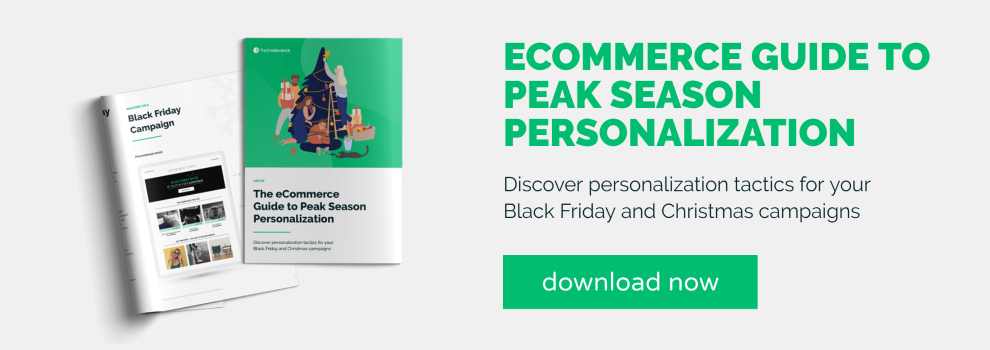Peak season seems to start earlier each year. In fact, John Lewis department store revealed that festive searches reached a record high on its website in August. Add this year’s panic buying into the mix and it’s looking to be an interesting one for eCommerce businesses.
The festive period will likely be a frenzied marathon that companies can benefit from if they can get it right.
Enter Amazon. The eCommerce giant’s strength in convenience, relevance, service and trust means they’re well equipped for dealing with surges of panic buying and peak season chaos.
Amazon’s overall revenues have increased to $113bn, up 27% from last year. Along with eBay, Amazon dominates the landscape of online marketplaces favored by UK consumers. Amazon has 407 million visits per month from the UK and eBay has 298 million. To put that into perspective, the population of the UK is around 68 million.
What’s more, our own research into consumers’ festive shopping habits shows that more people are opting to do their festive shopping primarily with Amazon and other online marketplaces.

Source: The New Normal Festive Shopping Report
But all is not lost. In this article, we’ll look at four ways to beat Amazon at their own game and cut yourself a slice of the peak season pie.
Read on to discover how to excel in Amazon’s four key areas of strength:
- Convenience
- Relevance
- Service
- Trust
1) Convenience
With their 3-click checkout, Amazon fosters a smooth and easy buying process for their customers.
Payment providers such as PayPal and Klarna can help you compete in this area, especially when the payment options are personalized to highlight the most simple and frictionless checkout method for an individual. Have you ever been reminded that you already have payment details saved with an eCommerce site? It makes completing your purchase a breeze.
LSE Retail uses a dynamic banner on their product pages to highlight the option to pay via Klarna, displaying the exact cost per payment.
With their dynamic banners, LSE Retail can personalize the experience for each customer by displaying the specific costs of each Klarna payment. This has led LSE Retail to achieve an 11% uplift in payments through Klarna across their Iconic Lights and Value Lights brands.

Source: iconiclights.co.uk
2) Relevance
A personalization strategy should always balance the interest of the business with the interest of the consumer. There’s no point promoting products that suit your margins if they’re out of stock or not interesting to the individual, for example.
Amazon is famed for its product recommendations. But the eCommerce giant doesn’t always get it right and their CX suffers because of this. Their ‘frequently bought with these products’ don’t guarantee compatibility and often result in random recommendations (see the school bag and kitchen knife combo as an example). This is where eCommerce businesses can step up by using product recommendation software that also allows you to manually include and exclude certain products or categories in your recommendations.
What’s more, Amazon’s post-purchase product recommendations leave much to be desired, often recommending more of the same type of product (being shown different types of mops when you’ve just bought one isn’t particularly useful, for example). Ecommerce businesses can get the upper hand here by sending recommendations for products that complement the one the shopper has just bought. In fact, 1 in 4 consumers say they want retailers to show them complementary products.
Reiss sends customers a post-purchase email to recommend products that they are likely to want and need directly after their original purchase.

Source: Reiss email
3) Service
Shoppers may be tempted to shop with Amazon for their last minute needs thanks to speedy delivery turnaround times, but even without Amazon’s fulfilment infrastructure, there are ways you can compete using clever personalization and optimization.
Balancing product and individual-level personalization can give you scope to build trust in similar ways by highlighting some great elements of your service. Here are a few ways to do this:
Countdown timers
Try including countdown timers on your website to highlight specific delivery windows, for example the cut-off for next day delivery. More than 1 in 4 consumers want retailers to highlight important cut-off dates, so this is an essential tactic to include.
Jewellerybox’s dynamic countdown timer draws shoppers’ attention to the same day shipping deadline, increasing urgency and decreasing click to purchase as customers know they have a limited amount of time.
Since implementing the countdown timer, Jewellerybox has seen a 5% increase in conversion rates in the two hours prior to the same day shipping cut off.

Source: jewellerybox.co.uk
In-store availability
This geotargeting tactic helps customers make a purchase decision and complete any last minute shopping by showing whether the product they are browsing is available at their nearest store.
Almost half of consumers (42%) want online retailers to display stock availability at their nearest store for products they are browsing.
H.Samuel gives shoppers the option to manually input their postcode or use their geolocation to see in-store availability of products.

Source: hsamuel.co.uk
Advanced triggers
If you haven’t already taken your triggered email program beyond cart and browse abandonment, you’re missing a trick. Send price drop emails to alert shoppers that a product they have browsed has dropped in price. Also, trigger back in stock emails when an out of stock product a shopper browsed comes becomes restocked.
Wex Photo Video ticks all the boxes with their back in stock email by including a clear header along with a prominent image of the product the recipient previously browsed. The addition of star ratings provides a nice element of social proof, showing the shopper that this is a trusted product worth buying. The company also boosts urgency by reminding the shopper that the product might run out again soon.

Source: Wex Photo Video email
4) Trust
Trust signals are a big part of Amazon’s site, with bestseller categories and trending deals highlighted on the homepage and star ratings and reviews featured heavily on product pages.
Almost 2 in 3 consumers find detailed product reviews useful when making a purchase, and over half of consumers look for star ratings when making a decision, making these essential tactics to include in your marketing.
Vision Direct builds trust with new shoppers immediately by displaying their Trustpilot rating on their homepage with several 5 star reviews underneath.

Beyond ratings and reviews, adding popularity messaging and stock levels to your marketing can help build trust and boost urgency.
Cooksongold prominently displays how many other shoppers have purchased the product recently, signalling to shoppers that it’s in high demand.

Source: cooksongold.com
User-generated content is another effective form of social proof to include, especially since almost 1 in 3 consumers prefer to see a product as it is worn or used by real people as opposed to professional product images.
By including customers’ photos on their product pages, & Other Stories gives shoppers an accurate idea of how the product will fit into their lives, building trust with their brand and boosting conversions.

Source: stories.com
Final thoughts
This year is a continuation of the ‘not normal’ theme, with the only norms being disruption, the threat of Amazon, and lots of new online shoppers wanting products to be delivered on time.
However, by tapping into Amazon’s four key strengths discussed above using personalization, optimization and social proof tactics, you’ll be well placed to succeed this peak season and even exploit Amazon’s weaknesses with a better customer experience.
Firstly, foster a simple and frictionless checkout experience with personalization and payment providers such as PayPal and Klarna.
Secondly, be smart about your product recommendation strategy to improve the customer experience with relevant recommendations that resonate with the individual.
Thirdly, use countdown timers, geotargeting and advanced triggered emails to offer customer service that blows Amazon’s speedy fulfilment out of the water.
Lastly, build trust with social proof tactics, such as ratings and reviews, popularity messaging and user-generated content.
Prep for peak season success with our Ecommerce Guide to Peak Season Personalization, packed with helpful tactics, pro tips and visual examples of holiday content.







